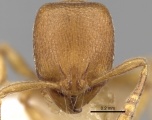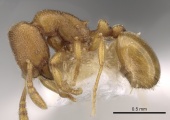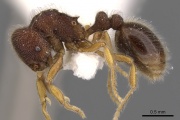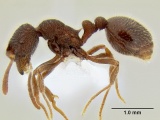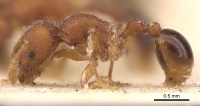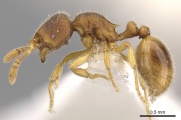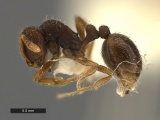Key to Rogeria Species
The following key to Rogeria workers is based on Kugler, C. 1994. A revision of the ant genus Rogeria with description of the sting apparatus (Hymenoptera: Formicidae). Journal of Hymenoptera Research. 3: 17-89.
The figures given in the key refer to line drawings. When figures are included with a couplet that ends with a species name, the line drawings can be found on the respective Antwiki species page.
1
- Pilosity appressed on mesosoma dorsum and gaster T1. A very small number of short decumbent hairs may also be present . . . . . 2
- Erect, suberect, or subdecumbent hairs present on mesosoma or gaster T1, often in addition to appressed or decumbent pilosity . . . . . 4
2
return to couplet #1
- Body of clypeus strongly projecting over apron. Basal angle of mandibles very reduced. (amazonian Brazil) (Fig. 14) . . . . . Rogeria prominula
- Body of clypeus at most projecting only slightly over apron. Mandibles triangular . . . . . 3
3
return to couplet #2
- Clypeal apron emarginate. Mandible with 5 teeth. (Paraguay, Argentina) (Fig. 82) . . . . . Rogeria bruchi
- Clypeal apron convex, often with faint median angle. Mandible with 6-7 teeth. (Caribbean, southwestern United States through northern South America) (Figs. 79-81, 104-105) . . . . . Rogeria foreli
4
return to couplet #1
- Very dense, flexuous, erect hairs on dorsa of head, mesosoma and gaster; no decumbent or appressed pilosity. Promesonotum uniformly and densely areolate . . . . . 5
- Erect hair not so dense or flexuous. Decumbent hair present. Promesonotum may have some rugae or carinae . . . . . 7
5
return to couplet #4
- Metanotum forms an abrupt declivity between promesonotum and propodeum. (lowland Colombia, Ecuador) (Figs. 5-6) . . . . . Rogeria gibba
- Shallow metanotal groove hardly interrupts mesosoma profile . . . . . 6
6
return to couplet #5
- Petiolar node relatively short and tall. Gaster larger (GW /WL 0.94-0.97). (lowland Ecuador, Venezuela) (Figs. 2-4) . . . . . Rogeria ciliosa
- Petiolar node relatively long and low. Gaster smaller (GW /WL 0.63-0.70). (Central and South America) (Figs. 83-84) . . . . . Rogeria blanda
7
return to couplet #4
- Ventral process of petiolar peduncle reduced to a small step in petiolar profile, or absent . . . . . 8
- Ventral process of petiolar peduncle dentate . . . . . 10
8
return to couplet #7
- Propodeal spines longer (PSI 0.17-0.20). Ventral process of petiolar peduncle present as a small step. (Paraguay, Peru, Colombia) (Figs. 15-16) . . . . . Rogeria besucheti
- Propodeal spines shorter (PSI 0.07-0.13). Petiolar peduncle lacking a ventral process . . . . . 9
9
return to couplet #8
- WL 0.72-0.92mm. (Pacific Islands) (Figs. 7-12) . . . . . Rogeria stigmatica
- WL 1.18-1.30mm. (Solomon Islands) (Fig. 13) . . . . . Rogeria megastigmatica
10
return to couplet #7
- WL 1.28-1.53mm. Eye large (80-100 facets). Postpetiole with an inconspicuous sternum. (Guyana, amazonian Brazil) (Fig. 18) . . . . . Rogeria procera
- WL and eyes usually much smaller. If WL and eyes nearly as large, then postpetiolar sternum conspicuous . . . . . 11
11
return to couplet #10
- Sparse, stiff, erect-suberect hairs and short appressed hairs on dorsa of head, mesosoma, waist, and gaster T1. WL > 0.72mm. Eye with > 25 facets . . . . . 12
- Erect hairs more curved and tapered; shorter pilosity, if present, usually decumbent. If some erect hairs are stiff, then WL and eye are smaller . . . . . 14
12
return to couplet #11
- Propodeal spines very short (PSI 0.09-0.12). Pygidium with a pair of median tubercles just above the sting. (eastern Brazil) (Figs. 22-23) . . . . . Rogeria subarmata
- Propodeal spines longer (PSI > 0.15). Pygidial tubercles lacking . . . . . 13
13
return to couplet #12
- Macrosculpture vestigial or absent on lateral pronotum and petiolar node. Waist slender (PpetW/PpetL 1.08-1.16). (Costa Rica) (Fig. 21) . . . . . Rogeria terescandens
- Lateral pronotum with distinct rugae, petiolar node strongly rugose to areolate-rugose. Waist inflated (PpetW /PpetL 1.38- 1.61). (Central America) (Figs. 19-20) . . . . . Rogeria scandens
14
return to couplet #11
- Petiole clavate. Eye with 39-48 facets. (Central America) (Figs. 85-86) . . . . . Rogeria tonduzi
- Petiole with a distinct node and/or smaller eyes . . . . . 15
15
return to couplet #14
- Undamaged hair on mesosoma dorsum mostly erect to suberect. Decumbent hairs, if present, much less abundant than longer, more erect pilosity . . . . . 16
- Mesosoma dorsum with abundant appressed or decumbent pilosity, usually in addition to longer erect to suberect hair . . . . . 21
16
return to couplet #15
- EL/SpL > 1.00. Gaster T1 usually lacks decumbent and appressed pilosity (occasionally 1 or 2
decumbent hairs present). (Central America) (Figs. 40-42) . . . . . Rogeria inermis
- EL/SpL usually < 0.90. If greater (some belti), then gaster T1 with abundant decumbent pilosity . . . . . 17
17
return to couplet #16
- Clypeal apron with median tooth . . . . . 18
- Clypeus emarginate to evenly convex . . . . . 19
18
return to couplet #17
- Promesonotum with thick rounded vermiculate rugae. Metapleural lobes well developed, triangular. (Trinidad, Guyana, amazonian Peru and Colombia, Mato Grosso) (Figs. 28-30, 89-90) . . . . . Rogeria lirata
- Promesonotum areolate-rugose to vermiculate rugose; rugae narrower, sharper. Metapleural lobes low, broadly rounded. (Paraguay, Mato Grosso and Minas Gerais) (Figs. 24-27, 87-88) . . . . . Rogeria germaini
19
return to couplet #17
- Eyes small and propodeal spines long and horizontal (EL/SpL < 0.46). (Belize, southern Mexico) (Fig. 45) . . . . . Rogeria cornuta
- EL/SpL > 0.46. Propodeal spines more inclined . . . . . 20
20
return to couplet #19
- Eye smaller, elliptical (OI 0.13-0.14). Petiolar peduncle with lamellate keel. Sides of postpetiolar node distinctly areolate. (southern Brazil) (Fig. 31) . . . . . Rogeria lacertosa
- Eye larger, oval (OI 0.18-0.22). Petiolar keel not lamellate. Sides of postpetiolar node smooth, or nearly so. (southern Mexico to Colombia) (Figs. 35-39, 91-92) . . . . . Rogeria belti
21
return to couplet #15
- Scapes with longer erect to suberect hair in addition to shorter decumbent to appressed pilosity (in exsulans and some brunnea, erect hairs can be sparse and little longer than decumbent hair) . . . . . 33
- No erect hair on scapes . . . . . 22
22
return to couplet #21
- WL 0.90-0.99mm. EL /SpL 0.48-0.56. (southern Brazil) (Figs. 32-33) . . . . . Rogeria pellecta
- Smaller. If WL approaches 0.90mm, then EL/SpL either < 0.30 or > 0.70 . . . . . 23
23
return to couplet #22
- Propodeal spines very long (PSI 0.29), strongly inclined. Eye small (EL/SpL 0.13). (southern Brazil) (Fig. 34) . . . . . Rogeria sicaria
- Propodeal spines usually much shorter. If similar in size, then not strongly inclined. EL/SpL >0.20 . . . . . 24
24
return to couplet #23
- WL > 0.71mm. Pilosity on gaster not differentiated into two distinct kinds. (Costa Rica) (Fig. 43) . . . . . Rogeria neilyensis
- WL usually < 0.71mm. If similar in size, hair on gaster differentiated into short-decumbent and longer-erect . . . . . 25
25
return to couplet #24
- Clypeal apron with median tooth. Gaster T3 with short median spine. (Colombia) (Fig. 63) . . . . . Rogeria tribrocca
- Clypeal apron without a median tooth. Gaster T3 unarmed . . . . . 26
26
return to couplet #25
- Erect-suberect hairs absent from head dorsum (or short and limited to posterior head) and sparse on mesosoma. WL 0.51-0.63mm . . . . . 27
- Erect hair present on middorsum and posterior head. If missing (scobinata), then > 10 pairs of erect hairs on mesosoma dorsum . . . . . 28
27
return to couplet #26
- Postpetiolar sternum wedge-shaped in side view; node less vaulted. Sides of head and pronotum strongly microareolate, making macrosculpture (if present) difficult to see. (central Mexico to Costa Rica) (Figs. 77-78, 103) . . . . . Rogeria cuneola
- Postpetiolar sternum not wedge-shaped; node more vaulted. Sides of head and pronotum with more or less smooth, shiny intervals. (Caribbean Islands, northern South America; possibly Central America) (Figs. 74-76, 101-102) . . . . . Rogeria curvipubens
28
return to couplet #26
- Part of gaster T1 microareolate. Most erect hairs stiff, cuneate-fimbriate. (Argentina) (Figs. 72-73) . . . . . Rogeria minima
- Gaster T1 smooth. Stiff hairs absent (except on some micromma) . . . . . 29
29
return to couplet #28
- Rugae on pronotal dorsum and sides unbranching and nearly straight, with smooth and shiny intervals. Sides of head below eye nearly smooth, strongly shining. (northeastern Colombia over 1000m) (Figs. 65, 94) . . . . . Rogeria nevadensis
- Rugae on promesonotum and sides of pronotum undulating and with lateral spurs or branches, sometimes forming areolate patches; intervals appear granular, not strongly shining. Sides of head rugose-areolate . . . . . 30
30
return to couplet #29
- Eye with 2-5 facets. Mesosoma sides opaque with dense areolate microsculpture, but macrosculpture absent. Mesosoma dorsum with 8-10 pairs of erect hairs. (Surinam, Para State of Brazil) (Fig. 71) . . . . . Rogeria micromma
- Eye with 4-21 facets (rarely < 7). Mesosoma sides with rugose macrosculpture in addition to weak or distinct microsculpture. Mesosoma dorsum with ≥ 12 pairs of erect hairs . . . . . 31
31
return to couplet #30
- Macrosculpture tuberculate on posterodorsum of head (Fig. 100). Erect hair usually absent from head dorsum, but sometimes short, sparse and mostly limited to posterior rim. (Trinidad, South America east of Andes to Paraguay) (Figs. 61-62, 100) . . . . . Rogeria scobinata
- Posterodorsum of head rugose to areolate; no tubercles. Middorsum of head with long erect hair . . . . . 32
32
return to couplet #31
- Clypeal apron convex. Nuchal groove clearly visible in lateral view. Propodeal spines generally wider. Petiolar keel distinct. (Mexico, Nicaragua; possibly into Colombia) (Figs. 55-57, 97-98) . . . . . Rogeria innotabilis
- Clypeal apron truncate in Central America. Nuchal groove not clearly visible in lateral view. Propodeal spines usually slender. Petiolar peduncle with little or no keel. (Panama, South America, Dominican Republic) (Figs. 58-60, 99) . . . . . Rogeria alzatei
33
return to couplet #21
- WL 0.93-1.02mm. Propodeal spines long (SpL > 0.20mm; PSI > 0.25), horizontal. Gaster with few or no decumbent hairs. (Belize, southern Mexico) (Fig. 45) . . . . . Rogeria cornuta
- WL usually < 0.90mm. If larger (some belti, brunnea, creightoni), then decumbent hair abundant on gaster . . . . . 34
34
return to couplet #33
- Gaster T1 with two distinct kinds of pilosity: shorter, decumbent hairs and longer, erect hairs . . . . . 36
- Hair on gaster T1 not clearly sorting into two distinct kinds . . . . . 35
35
return to couplet #34
- Pilosity on gaster T1 more dense and decumbent to subdecumbent. Petiolar peduncle with very large keel. (Samoa) (Fig. 44) . . . . . Rogeria exsulans
- Pilosity on gaster T1 more sparse and erect to subdecumbent. Petiolar peduncle with little or no keel. (Central America) (Figs. 40-42) . . . . . Rogeria inermis
36
return to couplet #34
- Eyes larger (> 19 facets), oval. Macrosculpture on pronotal disc usually predominantly areolate and extending uninterrupted onto anterior face of pronotum (if predominantly rugose, then eye with > 25 facets). (southern Mexico to Colombia) (Figs. 35-39, 91-92) . . . . . Rogeria belti
- Eyes smaller, often elliptical. Pronotal disc predominantly longitudinally rugose, vermiculate, or carinate. Anterior edge of disc transversely rugose, rugose-areolate, or carinate . . . . . 37
37
return to couplet #36
- Promesonotum with nearly straight, longitudinal carinae; no lateral branches; intervals very smooth and shiny. Eye small, elliptical (EL < 0.10. (Caribbean Islands) (Fig. 64) . . . . . Rogeria carinata
- Rogeria-carinataH8.jpg
- Rogeria-carinataL6.3.jpg
- Promesonotum longitudinally rugose, vermiculate, or rugose-areolate. If intervals smooth and shiny, then eyes oval and EL > 0.10 . . . . . 38
38
return to couplet #37
- Clypeus evenly convex. Postpetiolar node from above subtrapezoidal; sternum long, flat, without anterior lip. (Caribbean Islands) (Figs. 50, 93) . . . . . Rogeria brunnea
- Clypeus usually emarginate or truncate. If convex, then postpetiolar node not subtrapezoidal; sternum shorter, with distinct anterior lip . . . . . 39
39
return to couplet #38
- Eye elongate-oval. A strong transverse carina runs across pronotal shoulders. Pronotal disc and sides with weakly undulating rugae and nearly smooth interrugal spaces. Propodeal spines often with downcurved tips. (Venezuela) (Fig. 49) . . . . . Rogeria unguispina
- Eyes not elongate. Anterior pronotum may have 1 or more transverse rugae, but not carinae. Pronotal disc rugose or rugose-areolate. Propodeal spines straight . . . . . 40
40
return to couplet #39
- WL 0.54-0.66mm. Mesosoma low, slender (PW < 0.37mm). Propodeal spines short, sometimes absent (SpL < 0.11 mm). Postpetiole generally widest in anterior half (Fig. 66) (southern Mexico, Central America, Dominican Republic) (Figs. 66-70) . . . . . Rogeria leptonana
- Generally larger, with MHI > 0.90, PW > 0.37mm, and SpL > 0.10mm. Postpetiole subtrapezoidal or subrectangular (Figs. 51, 53) . . . . . 41
41
return to couplet #40
- Metanotum strongly interrupts contour of mesosoma profile. Sides of head rugose or effaced rugose-areolate. EL/SpL > 0.65. (Colombian and Ecuadorian Andes above 1000m) (Figs. 46-48) . . . . . Rogeria merenbergiana
- Metanotum with little or no effect on overall shape of mesosoma profile. EL/SpL < 0.65. Sides of head rugose-areolate; not effaced. (southern Texas to Panama) (Figs. 51-54, 95-96) . . . . . Rogeria creightoni


